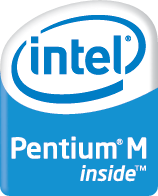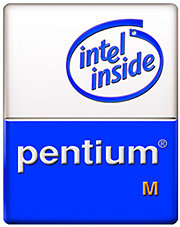Intel Pentium M
| << Intel Pentium M >> | |
|---|---|
 Logo of the Intel Pentium M |
|
| Production: | 2003 to 2008 |
| Producer: | Intel |
| Processor clock: | 900 MHz to 2.26 GHz |
| FSB cycle: | 100 MHz to 133 MHz |
| L2 cache size: | 1 MiB to 2 MiB |
| Manufacturing : | 130 nm to 90 nm |
| Instruction set : | x86 (16 bit) and x86-32 |
| Microarchitecture : | Pentium M |
| Base: | Socket 479 |
Names of the processor cores:
|
|
The Intel Pentium M is a 32-bit - x86 processor based on the P6 architecture , specifically designed for use in notebook computers has been developed and was launched in March of 2003. Its success led Intel to phase out the Pentium 4 family, which was suffering from power consumption and heat problems , and instead developed the new processor families Intel Core and Intel Core 2 , based on the technology of the Pentium M.
architecture
The Pentium M is not an energy-saving version of the Pentium 4 , but a heavily modified Pentium III , which is a slight modification of the Pentium II , which in turn represents a significantly improved evolution of the forefather of the P6 processors, the Pentium Pro . The Pentium M is optimized for low power consumption (see: → Thermal Design Power ), as this helps to extend the battery life of notebooks . The Pentium M achieves a significantly higher computing power than the Pentium 4 at the same rate.
development
The Pentium M was developed in Intel's research and development laboratory (Israel Development Center, IDC) in Haifa , Israel , which thanks to its great success gained a lot of reputation within the company. The code names for the individual models ( Banias and Dothan ) refer to biblical places ( Banias is a city in the Golan Heights and one of the sources of the Jordan , Dothan is a biblical city near today's Nablus ).
Banias
In principle, Banias combines the core of a Pentium III with a Pentium 4-compatible bus interface , an improved control unit and twice the amount of cache (64 KiB L1 and 1 MiB L2 cache, for comparison Pentium III: 32 KiB L1 and 256 or 512 KiB L2 cache). In the normally relatively energy-hungry L2 cache, the Banias design uses a new type of technology that reduces the power loss of the parts that are not currently needed. The clock and core voltage of the CPU are also throttled during operation if only little computing power (“idle” status) is required (around 600 MHz are typical). Intel calls this technology " SpeedStep ".
In addition to the Pentium M, the first models of the cheaper Celeron M are also based on the Banias core. With this processor, half of the L2 cache is deactivated, which means that you can still use defective banias - dies whose defects are in the deactivated part. Intel took a similar approach at the time with the 486SX processor, which was a 486DX with the FPU switched off . In this way, the production yield can be increased and costs can be reduced, which is (partly) reflected in the low sales prices. The Celeron M with Banias core therefore only has 512 KiB L2 cache. Furthermore, some SpeedStep functions of the Banias in the Celeron M have been trimmed so that the power consumption of a Celeron M is higher when idling than with an otherwise identical Pentium M.
A special feature of the Banias models is that, like the Dothan models, they support PAE , but in contrast to the Dothan models, they do not communicate this via CPUID . Under Linux there is therefore the possibility of using PAE despite the missing CPUID flag if a Banias processor was recognized.
Dothan
On May 10, 2004, Intel released an improved version of the Banias : Dothan . These processors were the first from Intel to be designated with a three-digit number instead of the processor clock (e.g. 2 GHz), e.g. E.g .: 725 (1.6 GHz), 755 (2.0 GHz) or 780 (2.26 GHz). The design was essentially taken from the old Banias core, but the L2 cache was increased to 2 MiB . Is manufactured Dothan in a 90-nm process, what the TDP decreases from 24.5 to 21 watts. In contrast, the power loss when idling increased a little. On average, the 90 nm production results in only very small advantages with regard to the battery life of a notebook, which are offset by clear performance advantages mainly due to the doubled cache.
On January 19, 2005, Intel presented new models that worked with 133 MHz FSB (FSB533), which further increased the memory throughput and the overall performance of the Pentium M. This was bought with the disadvantage that the minimum possible clock rate of 600 MHz so far increased, since the smallest multiplier (= 6) now results in a CPU clock rate of 800 MHz at 133 MHz (FSB).
All models with FSB 533 and models with FSB 400 and CPU-ID 06D8h have the “Execute-Disable XD-Bit ” (“No-Execution-Flag”), which is supposed to prevent the CPU from executing program code from stack and data areas .
Also from Dothan a price cheaper version exists again under the trade name Celeron M . As with Banias , half of the L2 cache in the Celeron M has been deactivated in order not to endanger the demand for Pentium M. The Celeron M with Dothan core also only works with FSB400 and the operating voltage and clock frequency are not reduced when idling. For marketing reasons, the Centrino logo is not assigned to systems with Celeron M.
successor
At the beginning of 2006, Intel presented the next generation of notebook processors with the Core Solo and Core Duo . The technology of the Pentium M was continued with new processors, further developed and transferred as Core 2 to the desktop processors. The Pentium M is considered to be the first step in the development of the Intel Core microarchitecture .
Apple TV
A special edition of the Intel Pentium M with the name “Crofton” and a clock rate of 1 GHz was used in the first generation of the Apple TV . It was a downclocked Dothan core.
Model data
Banias
- L1 cache : 32 + 32 KiB (data + instructions)
- L2 cache: 1024 KiB with processor clock
- MMX , SSE , SSE2 , EIST
- Socket 479 , AGTL + with 100 MHz (quadpumped: FSB400)
- Operating voltage ( VCore ): Standard models: 1.484 or (only 1.3 GHz :) 1.388 volts; LV : 1.180 volts; ULV : 1.004 volts
- Power Dissipation ( TDP ): Standard models: 22–24.5 watts; LV models: 12 watts; ULV models: 7 watts
- Release DATE: March 2003
- Manufacturing technology: 130 nm
- The size: 82.8 mm² with 77 million transistors
- CPUID 0x69?
- Clock rates: standard models: 1.3–1.7 GHz; LV models: 1.1-1.3 GHz; ULV models: 900 MHz – 1.1 GHz
-
Model numbers (all models with FSB400):
- Standard models ( TDP : 22-24.5 W):
- Pentium M 1.3 GHz (TDP: 22 W) *
- Pentium M 1.4 GHz (TDP: 22 W) *
- Pentium M 1.5 GHz (TDP: 24.5 W) *
- Pentium M 1.6 GHz (TDP: 24.5 W) *
- Pentium M 1.7 GHz (TDP: 24.5 W) *
- 705: 1.5 GHz (TDP: 24.5 W) - corresponds to Pentium M 1.5 GHz
-
LV models ( TDP : 12 W):
- Pentium M LV 1.1 GHz *
- Pentium M LV 1.2 GHz *
- 718: 1.3 GHz
-
ULV models ( TDP : 7 W):
- Pentium M ULV 900 MHz *
- Pentium M ULV 1.0 GHz *
- 713: 1.1 GHz
- Standard models ( TDP : 22-24.5 W):
* Intel didn't introduce model numbers until after these models appeared
Dothan
- L1 cache : 32 + 32 KiB (data + instructions)
- L2 cache: 2048 KiB with processor clock
- MMX , SSE , SSE2 , EIST , XD-Bit (newer models), PAE (newer models)
- Socket 479 , AGTL + with 100 and 133 MHz (quadpumped: FSB400 and FSB533)
- Operating voltage ( VCore ): 1.276-1.340V
- Power dissipation ( TDP ): 10-27 W.
- Release date: May 2004, January 2005 (FSB533 versions)
- Manufacturing technology: 90 nm
- The size: 83.6 mm² with 140 million transistors
- CPUID 0x6D?
- XD-Bit : FSB533 all models, FSB400 only models with CPUID 0x6D8
- Clock rates: 1.4–2.26 GHz
-
Model Numbers :
- Standard models with FSB400 ( TDP : 21 W):
- 710: 1.40 GHz
- 715: 1.50 GHz
- 725: 1.60 GHz (725A with XD bit)
- 735: 1.70 GHz (735A with XD bit)
- 745: 1.80 GHz (745A with XD bit)
- 755: 2.00 GHz
- 765: 2.10 GHz (with XD bit)
- Standard models with FSB533 ( TDP : 27 W), with XD bit :
- 730: 1.60 GHz
- 740: 1.73 GHz
- 750: 1.86 GHz
- 760: 2.00 GHz
- 770: 2.13 GHz
- 780: 2.26 GHz
- LV models with FSB400 ( TDP : 10 W):
-
ULV models with FSB400 ( TDP : 5–5.5 W):
- 713: 1.10 GHz (TDP: 5 W), with XD bit
- 723: 1.00 GHz (TDP: 5 W)
- 733: 1.10 GHz (TDP: 5 W)
- 733J: 1.10 GHz (TDP: 5.5 W)
- 753: 1.20 GHz (TDP: 5.5 W)
- 773: 1.30 GHz (TDP: 5.5 W)
- Standard models with FSB400 ( TDP : 21 W):
Footnotes
- ↑ Andreas Stiller: Gam ve Gam - Intel's future comes from Israel, c't 3-2006, p. 94ff
- ↑ http://lkml.org/lkml/2014/2/25/18
- ↑ a b Intel Pentium M Processor on 90nm Process with 2MB L2 Cache Datasheet January 2006
- ↑ Jörg Wirtgen: Refreshed - Notebooks can calculate with new technology almost on a desktop level. In: Heise online . 2005 . Retrieved March 9, 2016.
- ^ Daniel Eran: Inside Apple TV. In: RoughlyDrafted Magazine. Daniel Eran, March 26, 2007, accessed November 12, 2011 .
- ↑ Jörg Wirtgen: Intel: Number 705 is alive. In: Heise online . July 15, 2004 . Retrieved March 9, 2016.
- ↑ Jörg Wirtgen: Undocumented Pentium M. In: Heise online . August 22, 2005 . Retrieved March 9, 2016.


